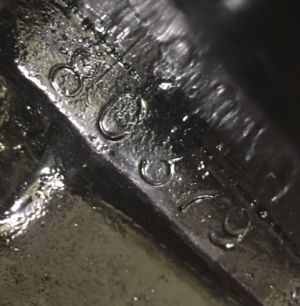- Home
- About Us
- Join/Renew
- Member Benefits
- Member Pages
- Log In
- Help
- Museum Store
Gentlemen
The engine that came with my basket case 836A is not original to the car. That became apparent upon disassembly of the engine. My first clue was that the head had a stamped number of 6 (not correct for a ’34). Next I measured the stroke and found out it was 5″ (385 cubic inches).
The engine does not have a number on the block above the water inlet. it is smooth and unaltered. When I got the cleaned block back from the machine shop I discovered a stamped number on the left front flange of the block. The number is 80379.
The engine also has full floating wrist pins and rod bearings without babbitt on the sides of the bearing (later engine). There may be other clues of which I am not aware.
Some have suggested that I have a Seagrave engine and it may be a 1936.
Any enlightenment on the subject would be appreciated.
“
Photos would help. Sure sounds like a seagrave motor. Unless you doing a Pebble Beach restoration the motor change won’t hurt the value of the car. For many the bigger motor will be a plus. I would be sure to use correct year engine accessories as they will be very noticeable if incorrect of off a fire truck. Probably less than ten percent of collectors would even realize the swap over. I would stamp the block with a correct year number on the motor, as that would be the biggest give away of the change. I would make an effort to get the correct size numbers, as often they are incorrect and that always draws attention.
Calvin,
Do you have a either/both a part number and casting dates cast in the block?
Bill
The engine number for an 836A would have six digits as in 240xxx. The eight cylinder engine number for 1933 is 235xxx, 1934 is 305xxx and for 1935 is 310xxx.
Update on Block numbers.
These are the numbers that are cast into the left side of the block. may these will shed some light into what I have.
702747
H24-2
S
I have attached a picture of the block numbering.
I will follow up with a picture of the number that is stamped into the front block flange.
And the stamped number

It’s a Seagrave engine, the S is not Seagrave, it for the South Bend foundry at Studebaker. Best guess, 1942 small pumper engine used at many small US government installations.
702 747 is the same casting as my ’33 and ’35 blocks, I think.
In support of Ed’s posting, that casting date doesn’t match Pierce protocol, because I think M is 1932 so what would that make H a 27?
Since the casting numbers will always show that the engine is not the original one for the ’34 836A, I do not think it is wise to stamp the block with a serial number from the 836A era or series. This would seriously raise some eyebrows when noticed by anyone researching the numbers..
To me, this ‘not original’ engine is a part of the normal service history of a car being used for transportation: Things wear out. So some things need replacing. The engine block without a stamped serial number, and with a later production date than the car’s production, implies that the car had a bum engine, and it was replaced with what was then an available replacement engine.
What did a Pierce Arrow dealership’s service department do when a Pierce’s engine had to have a new engine crankcase? Such as if the engine broke an oil line or fitting, and all the oil was pumped out while the car was out on the highway.. Then a connecting rod broke and knocked a hole in the crankcase ??
I’m sure new engine blocks were available to be used to build up a new engine. And they would not have any serial numbers stamped on the block. So the engine was rebuilt with a new crankcase.
I think it is perfectly OK to leave the engine serial number area blank on this engine. It certainly is more correct than having casting numbers and serial numbers from different model years.
Remember: our beloved Pierce Arrow cars went from being expensive, prestigious cars, to become just ‘old’ cars, selling for very little money. In the 1950’s, there are many stores of very nice Pierce Arrow cars selling for under $500, some for under $100 !! .
So, having a beautiful Pierce Arrow car, that was kept on the road and survived until today, by using a few years later Pierce or Pierce [by Seagrave] engine, is to me a natural and correct service history for a car.
Greg Long
Agree completely with Greg here: Our Cars once lived in the Real World, and that’s the way it is.
I’m just glad my Car wasn’t made into a tow truck or farm truck (or an Army tank, for that matter…) sometime in the past 90 years!
I agree with Greg. Who knows what the history of this car and engine. I’m just happy I have a good engine. When I am done with it it will be one sweet running engine.
The engine is what it is am I am OK with that.
By the way I have no intention of stamping any numbers on the block.
Thanks for all that have responded to my questions. You have all been very helpful.
Any time one can be learning it is exciting and is a good sign that we are not in the obituary
